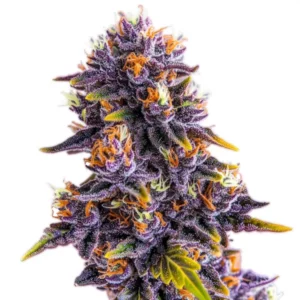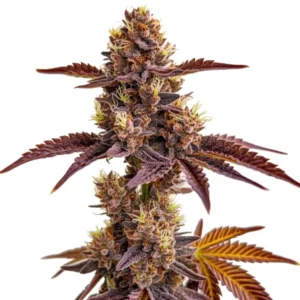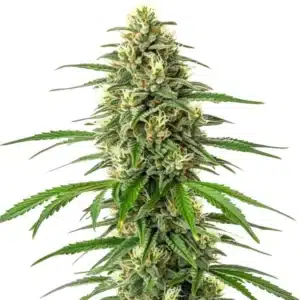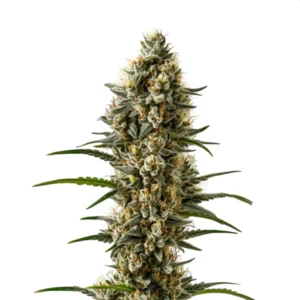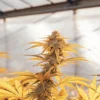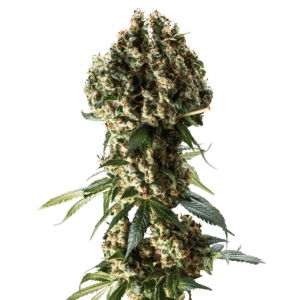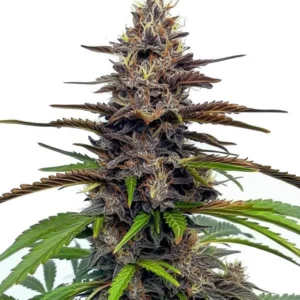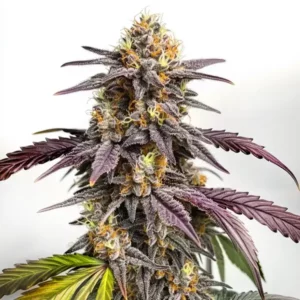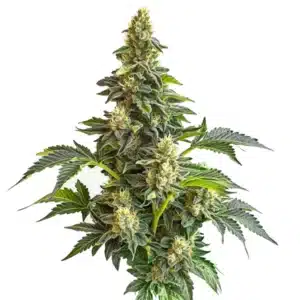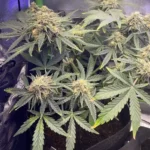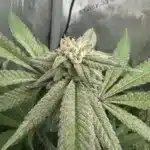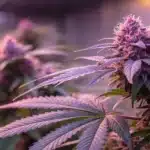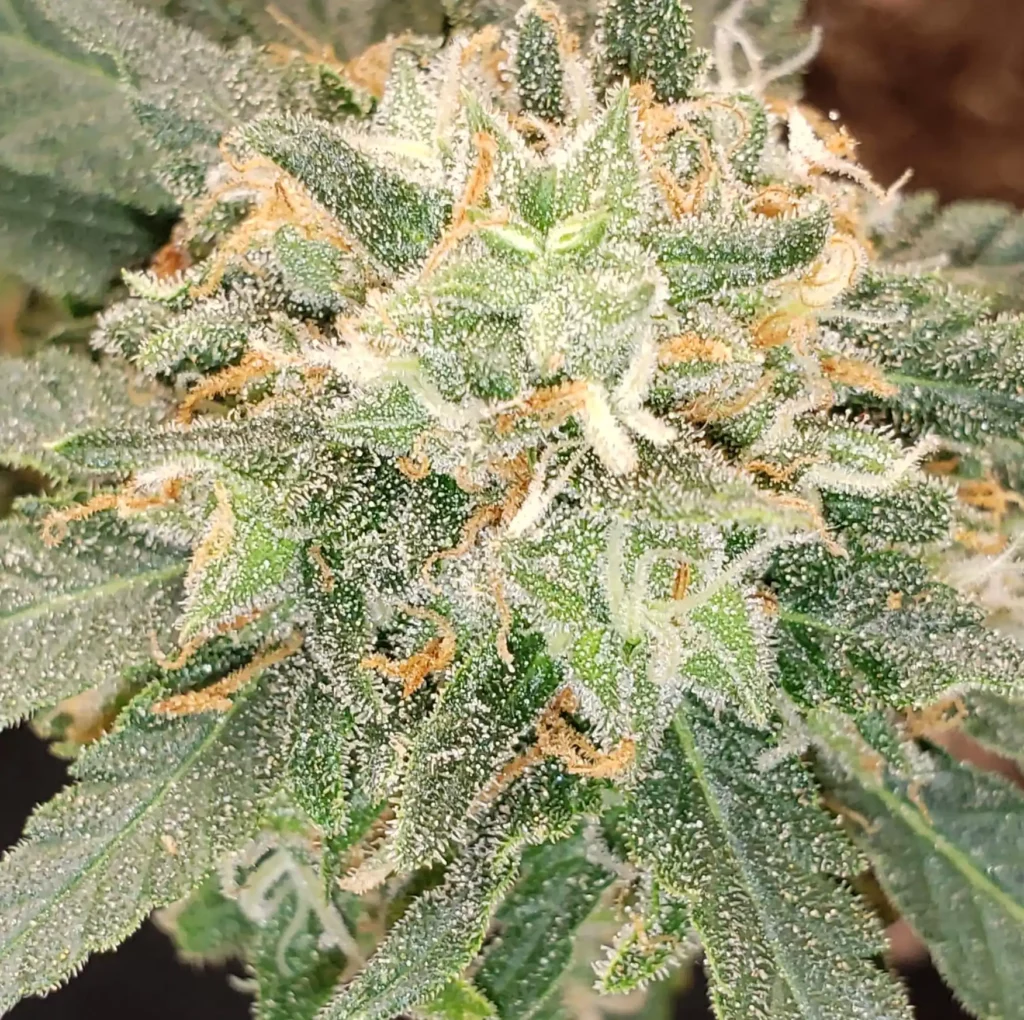
How to Grow Purple Star Killer
Purple Star Killer Description
Purple Star Killer Strain is an extraordinary cannabis strain, also known by some as Purple Star weed, highly favored for its potent effects and stunning appearance. This Indica-dominant strain is a cross between two powerful genetics, Death Star and Purple Kush, resulting in a plant that boasts impressive THC levels, often reaching up to 30%. The buds of Purple Star Killer are dense and beautifully colored, often showcasing deep purple hues mixed with dark green. They are coated in a thick layer of trichomes, giving them a frosty, sticky appearance that signifies their potency.
The aroma and flavor profile of Purple Star Killer is one of its most distinguishing features. It offers a blend of sweet and earthy notes with hints of berry and grape, making it a delightful strain for those who appreciate rich, flavorful cannabis. The dominant terpenes in this strain, such as Myrcene and Limonene, contribute to its relaxing and euphoric effects, making it an excellent choice for evening use or for those seeking relief from stress, pain, and insomnia.
Recommended Strains
Purple Star Killer
|
|
THC | 25% - 29% (High) |
|
|
Type | Feminized |
|
|
Yield | High |
|
|
Phenotype | 70% Indica / 30% Sativa |
Purple Star Killer HMC Edition
|
|
THC | 25% - 29% (High) |
|
|
Type | Feminized |
|
|
Yield | High |
|
|
Phenotype | 70% Indica / 30% Sativa |
Whether you are a recreational user or someone looking for medicinal benefits, Purple Star Killer delivers a powerful experience that can leave you deeply relaxed and content. This strain’s combination of high THC content, remarkable flavor, and therapeutic potential makes it a standout choice in the cannabis community.
Promos & Deals
Environmental Requirements for Growing Purple Star Killer
For those looking for comprehensive Star Killer strain grow info, this section outlines the optimal environment and key growing conditions for maximizing yields and potency.
Creating the ideal environment for growing Purple Star Killer is essential to achieving the best possible results. This strain thrives in controlled conditions where temperature, humidity, and light are carefully managed. Here’s what you need to know:
Temperature and Humidity: Purple Star Killer prefers a temperate climate, with daytime temperatures between 68-80°F (20-27°C) and slightly cooler temperatures at night. Maintaining a consistent temperature range is crucial to prevent stress, which could negatively impact growth and yield. Humidity levels should be kept between 40-50% during the flowering stage to prevent mold and mildew, which can be particularly problematic due to the density of the buds.
Lighting: For indoor cultivation, Purple Star Killer benefits from high-intensity lighting, such as LED grow lights or HPS lamps. During the vegetative stage, it’s recommended to provide 18-20 hours of light per day to encourage vigorous growth. When transitioning to the flowering stage, switch to a 12/12 light cycle (12 hours of light followed by 12 hours of darkness). This light schedule mimics the natural conditions that trigger flowering in cannabis plants and is essential for developing large, resinous buds.
For outdoor growers, Purple Star Killer requires a location with plenty of sunlight, ideally with full sun exposure throughout the day. This strain can also benefit from a greenhouse setup, especially in regions with shorter growing seasons or unpredictable weather patterns. The greenhouse environment can help extend the growing season and protect the plants from harsh environmental conditions.
Airflow and Ventilation: Good airflow is essential for maintaining the health of your Purple Star Killer plants. In an indoor setup, use fans to circulate air around the plants, which helps strengthen the stems and prevents the buildup of humidity. An exhaust system with a carbon filter is also recommended to manage odors and ensure fresh air intake, which is crucial for robust growth.
Soil and Nutrients: Purple Star Killer can be grown in soil, coco coir, or hydroponic systems. If using soil, choose a high-quality mix that is rich in organic matter and well-draining to avoid waterlogging the roots. This strain requires a nutrient-rich diet, particularly during the vegetative stage, where higher levels of nitrogen are needed. As the plant transitions to flowering, switch to a bloom-specific nutrient formula that emphasizes phosphorus and potassium to support bud development.
By closely monitoring and adjusting the environmental conditions, you can optimize the growth and potency of your Purple Star Killer plants, resulting in a high-quality harvest.
Setting Up the Growing Cannabis Space
Before you begin cultivating Purple Star Killer, it’s crucial to set up a well-organized and efficient growing space. Whether you choose to grow indoors or outdoors, the following factors will help you create the perfect environment for your plants:
Indoor Cannabis Cultivation
For indoor growers, selecting the right grow tent or dedicated grow room is essential. Purple Star Killer, with its dense and resinous buds, requires sufficient vertical space for growth and proper light distribution. Choose a grow tent that allows for easy access to the plants and includes reflective interior walls to maximize light efficiency.
Ventilation is key to a successful indoor grow. Install an exhaust system with a carbon filter to control odors and maintain fresh airflow. This system should be complemented by intake fans to bring in fresh air, ensuring a balanced environment in terms of temperature and humidity. Oscillating fans can further improve air circulation around the plants, reducing the risk of mold and mildew.
When it comes to the growing medium, Purple Star Killer thrives in both soil and hydroponic systems. High-quality soil that is rich in organic nutrients is ideal for beginners due to its ease of use. However, more experienced growers may prefer hydroponics for faster growth rates and potentially larger yields. Regardless of the medium, ensure that your setup includes proper drainage to prevent root rot and other water-related issues.
Outdoor Cannabis Cultivation
If you prefer growing cannabis outdoors, Purple Star Killer is a great choice due to its robust nature. The key to successful outdoor cultivation is choosing a location that receives full sunlight throughout the day. Purple Star Killer is adaptable to various climates, but it thrives in temperate regions with consistent warmth and sunlight.
When planting in soil, ensure it is well-draining and rich in organic matter to support healthy root development. Using raised beds or large containers can help control the soil quality and provide ample space for the roots to expand, which can lead to more vigorous growth and higher yields. Additionally, protecting your plants from strong winds is important, as the dense buds can cause branches to snap under pressure. Stakes or trellises can provide the necessary support and improve airflow around the buds.
Outdoor growers should also be vigilant about pests and environmental stresses. Regularly inspect your plants for signs of insects or disease, and take preventive measures such as using organic pest control solutions or introducing beneficial insects. In areas with unpredictable weather, consider using a greenhouse or other protective structures to shield your plants from excessive rain, wind, or cold temperatures.
Propagation and Germination of Purple Star Killer
Achieving successful propagation and germination is the first step toward cultivating healthy and productive Purple Star Killer plants. Here’s a step-by-step guide to help you get started:
- Seed Selection: Start by obtaining high-quality Purple Star Killer feminized seeds from a reputable seed bank like Blimburn Seeds. Feminized seeds ensure that all your plants will produce buds, eliminating the risk of male plants that do not yield the desired flowers.
- Germination Process: To germinate your seeds, you can either soak them in distilled water for 24-48 hours or place them between damp paper towels. Keep them in a warm, dark place with a temperature between 70-85°F (21-29°C). After a day or two, the seeds should begin to sprout small taproots.
- Planting the Seeds: Once the taproots have emerged, carefully transfer the seeds to a pre-moistened growing medium, such as a seedling tray or small pots filled with light, well-draining soil. Ensure the taproot is facing downwards and cover the seed lightly with soil.
- Early Seedling Care: Place the seedlings in a warm and humid environment with gentle airflow. A humidity dome can help maintain the ideal humidity levels of around 60-70%. Provide indirect light initially, gradually increasing light intensity as the seedlings grow stronger.
- Transplanting: Once the seedlings have developed a few sets of true leaves, they are ready to be transplanted into larger pots or directly into the ground. Handle the seedlings gently to avoid damaging the delicate roots, as this could stunt their growth.
By following these steps, you’ll be well on your way to establishing strong, healthy Purple Star Killer plants that will thrive throughout the growing cycle.
Vegetative Phase of Purple Star Killer
The vegetative phase is a critical period in the development of your Purple Star Killer plants. During this stage, the plants focus on building strength and structure, which will support the heavy buds that develop later. Here’s how to ensure your plants grow vigorously during this phase:
Lighting: If you’re growing indoors, provide your Purple Star Killer plants with 18-20 hours of light per day. LED grow lights are ideal as they offer a full spectrum of light and produce less heat compared to traditional HPS lamps. Ensure that the light is distributed evenly across the plants to avoid stretching or uneven growth.
Nutrients: During the vegetative phase, Purple Star Killer requires a nutrient-rich diet, particularly with higher levels of nitrogen, which supports the development of lush foliage and strong stems. Use a balanced cannabis fertilizer and follow the manufacturer’s instructions closely. Monitor the pH of the soil or nutrient solution to keep it within the optimal range (6.0-6.5) to ensure proper nutrient absorption.
Watering: Consistent watering is key during the vegetative phase. Water the plants when the top inch of the soil feels dry, but avoid overwatering, as this can lead to root rot. Allow the soil to dry out slightly between waterings to encourage healthy root development.
Training Techniques: To maximize your yield, consider using training techniques such as low-stress training (LST) or topping. LST involves gently bending and tying down the main stem and branches to create a more even canopy. This method allows light to penetrate deeper into the plant, reaching lower bud sites, which can result in a more uniform and abundant harvest. Topping, on the other hand, involves cutting the top of the main stem to encourage the plant to develop multiple main colas instead of just one. This can lead to a bushier plant with more bud sites, ultimately increasing your yield.
Pruning: During the vegetative phase, it’s also beneficial to remove any lower leaves or branches that are unlikely to receive adequate light. This helps improve airflow within the plant, reducing the risk of mold and mildew while allowing the plant to focus its energy on the more productive upper branches. Regular pruning also encourages the plant to develop a stronger structure, better capable of supporting the heavy buds that will form during the flowering phase.
Environmental Control: Maintaining a stable environment is crucial during the vegetative phase. Keep the temperature between 70-80°F (21-27°C) during the day, with a slight drop at night. Ensure good air circulation to strengthen the plants and prevent humidity-related issues. A relative humidity of 40-60% is ideal during this stage.
By optimizing these factors during the vegetative phase, you’ll set the stage for a successful transition into the flowering phase, where your Purple Star Killer plants will begin to produce their potent and aromatic buds.
Flowering Phase of Purple Star Killer
The flowering phase is the most exciting stage of growing Purple Star Killer, as this is when the plants start to develop the dense, resin-coated buds that are highly sought after. To achieve the best results, careful attention to environmental conditions, nutrition, and plant care is essential.
Lighting: As Purple Star Killer is a photoperiod strain, it requires a change in the light cycle to initiate flowering. Switch to a 12/12 light cycle (12 hours of light and 12 hours of uninterrupted darkness) to trigger the flowering stage. During this stage, it’s crucial to provide intense light to support bud development. High-quality LED grow lights or HPS lamps are recommended, ensuring that the light covers the entire canopy evenly. If you notice the plants stretching, adjust the distance between the lights and the canopy to prevent excessive elongation of the branches.
Nutrients: During the flowering stage, the nutrient needs of Purple Star Killer shift toward phosphorus and potassium, which are essential for bud formation. Transition from a high-nitrogen fertilizer used during the vegetative stage to a bloom-specific nutrient formula that supports flowering. It’s important to gradually reduce nitrogen levels to avoid excessive foliage growth at the expense of bud production. Continue monitoring the pH level, keeping it within the optimal range to ensure efficient nutrient uptake.
Temperature and Humidity: Maintaining slightly cooler temperatures during the flowering phase, ideally between 65-75°F (18-24°C), can encourage resin production and enhance the terpene profile, resulting in more flavorful and potent buds. Humidity should be lowered to around 40-50% to reduce the risk of mold or bud rot, especially as the buds become denser. This is particularly important for a strain like Purple Star Killer, which produces thick, resinous buds that are susceptible to moisture-related issues.
Supporting the Plants: As Purple Star Killer enters the flowering phase, the weight of the developing buds can cause the branches to droop or even break. To prevent this, use stakes, trellises, or other support structures to help bear the weight of the buds. This not only prevents damage but also improves light exposure and airflow around the buds, further enhancing their development and quality.
Flowering Time: Purple Star Killer typically has a flowering time of 8-10 weeks, but this can vary slightly depending on the growing conditions and phenotype. To determine the optimal harvest time, closely monitor the trichomes on the buds. Trichomes should appear milky or cloudy, with some turning amber, indicating the peak cannabinoid and terpene content. Harvesting at the right time is crucial for maximizing both the potency and the flavor of your buds.
Pest and Disease Management: Continue to inspect your plants regularly for any signs of pests or diseases, which can be particularly devastating during the flowering stage. Use organic or low-toxicity pest control methods if necessary, and ensure that your grow space remains clean and well-ventilated. Proper pest and disease management during the flowering phase will help ensure that your Purple Star Killer plants produce high-quality buds that are free from contamination.
By carefully managing these aspects during the flowering phase, you can ensure that your Purple Star Killer plants produce potent, flavorful buds that will satisfy even the most discerning cannabis connoisseurs.
Cannabis Fertilization and Nutrition
Proper fertilization and nutrition are critical to the successful cultivation of Purple Star Killer, influencing everything from growth rate to bud quality. Here are some key considerations for feeding your plants throughout their lifecycle:
Choosing the Right Fertilizer: Start with a balanced fertilizer that provides a good mix of macronutrients (nitrogen, phosphorus, and potassium) and micronutrients. During the vegetative stage, focus on fertilizers with a higher nitrogen content, which supports leaf and stem development. As the plants transition to the flowering stage, switch to a bloom-specific formula that is higher in phosphorus and potassium, which are essential for bud development and overall flowering performance.
Feeding Schedule: Establishing a regular feeding schedule is important for maintaining consistent growth. Follow the instructions provided by the fertilizer manufacturer, starting with a lower concentration and gradually increasing as the plants grow. Be cautious of overfeeding, which can lead to nutrient burn, characterized by yellowing and browning of the leaf edges. Conversely, underfeeding can cause nutrient deficiencies, resulting in stunted growth and poor bud development.
Supplements and Additives: Consider using supplements to enhance specific aspects of plant development. For example, bloom boosters can increase bud density, while products containing beneficial microbes can improve root health and nutrient absorption. Other popular additives include cal-mag supplements, which provide calcium and magnesium two essential nutrients that can sometimes be lacking in cannabis plants.
Monitoring and Adjustments: Regularly monitor your plants for signs of nutrient deficiencies or toxicities. Common symptoms include discolored leaves, slowed growth, or unusual spotting. Adjust your feeding regimen accordingly to address these issues. Additionally, flushing the plants with plain water during the last week or two before harvest helps to remove any excess salts or nutrients, improving the taste and quality of the final product.
By providing Purple Star Killer with the right nutrients at the right times, you’ll ensure vigorous growth and a bountiful harvest of high-quality buds.
Pest and Disease Control for Cannabis Growing
Even though Purple Star Killer is a resilient strain, it is still vulnerable to common pests and diseases that can affect cannabis plants. Implementing effective pest and disease control measures is essential to protecting your crop and ensuring a successful harvest.
Prevention: The best defense against pests and diseases is prevention. Start by maintaining a clean growing environment remove any dead plant material, clean your tools regularly, and avoid overwatering, which can create conditions conducive to mold and mildew. Introduce beneficial insects, such as ladybugs or predatory mites, to your garden as a natural way to control harmful pests like aphids, spider mites, and whiteflies. Ensure proper airflow and ventilation within your grow space to reduce humidity levels and prevent the onset of fungal infections like powdery mildew or botrytis (bud rot).
Monitoring: Regularly inspect your plants for signs of pest infestations or diseases. Look for discolored leaves, webbing, or spots on the foliage, which could indicate the presence of pests or fungal infections. Early detection is key to preventing a small problem from becoming a full-blown infestation.
Corrective Actions: If you do encounter pests or diseases, act quickly to minimize damage. For minor pest problems, use organic pesticides like neem oil, insecticidal soap, or diatomaceous earth, which are effective yet gentle on your plants. For more severe infestations, consider introducing more aggressive biological controls, such as predatory nematodes or commercially available predatory insects. When dealing with fungal diseases, prune affected areas and apply organic fungicides or a mixture of water and baking soda to inhibit further growth.
Integrated Pest Management (IPM): An IPM approach combines multiple strategies to manage pests and diseases effectively. This might include cultural practices (like crop rotation and companion planting), mechanical controls (such as traps and barriers), and biological controls (like beneficial insects). IPM is an eco-friendly way to protect your plants while minimizing the use of chemical pesticides.
By staying vigilant and implementing a proactive approach to pest and disease management, you can keep your Purple Star Killer plants healthy and thriving throughout the growing cycle.
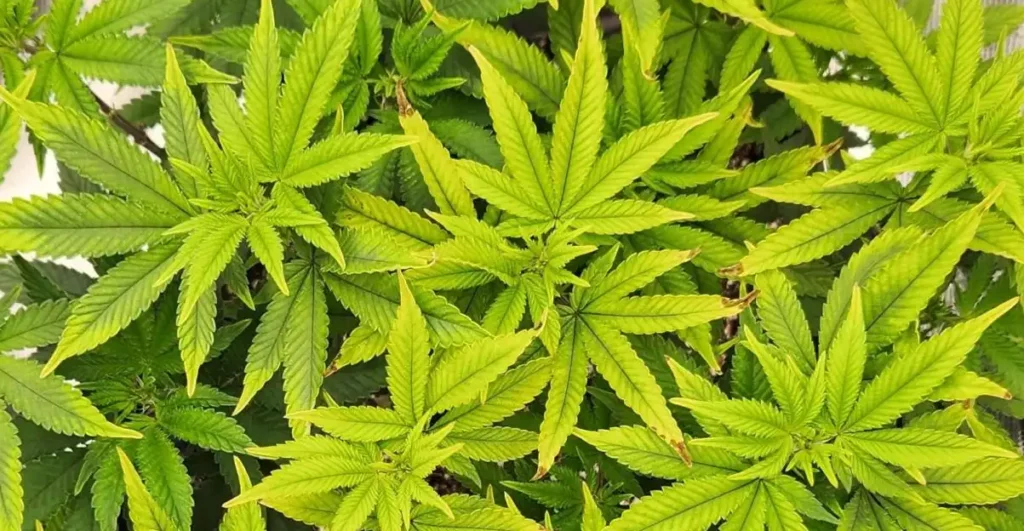
Harvesting and Curing for Cannabis Growing
Harvesting your Purple Star Killer plants at the right time and curing the buds properly are crucial steps in ensuring the best flavor, potency, and overall quality of your cannabis. Here’s how to do it:
Trichome Maturity: The most reliable way to determine when your plants are ready for harvest is by examining the trichomes the tiny, crystal-like structures on the buds that contain the plant’s cannabinoids and terpenes. Using a magnifying tool, look for trichomes that are mostly milky or cloudy with some turning amber. This indicates peak potency, with a balance of THC content and the desired effects.
Harvesting: When your plants are ready, use clean, sterilized scissors to carefully cut down the branches. Be gentle to avoid damaging the buds. Remove any large fan leaves, but leave the smaller sugar leaves, as they contribute to the final structure of the buds. This is especially important for Purple Star Killer, as the dense buds benefit from the additional support these leaves provide during drying.
Drying: Hang the cut branches upside down in a dark, well-ventilated area with a temperature between 60-70°F (15-21°C) and humidity levels around 50-60%. Proper airflow is crucial to prevent mold, so ensure the space is not overcrowded and that air can circulate freely around the hanging branches. The drying process typically takes 7-14 days, depending on environmental conditions. You’ll know the buds are ready for the next step when the smaller stems snap rather than bend.
Curing: After drying, carefully trim the buds from the branches and place them in airtight glass jars for curing. Store the jars in a cool, dark place with a temperature of around 60-70°F (15-21°C) and a humidity level of 58-62%. For the first week of curing, open the jars daily (a process known as “burping”) to allow excess moisture to escape. This step is critical for ensuring that the buds dry evenly and for preventing mold growth. After the first week, you can reduce the frequency of burping to once every few days.
Curing typically takes 2-4 weeks, but some growers choose to cure their buds for even longer up to several months for an even smoother, more refined flavor profile. Properly cured Purple Star Killer buds will have a rich, earthy aroma with hints of berry and grape, providing a premium smoking or vaping experience.
Is Purple Star Killer Indica or Sativa?
Purple Star Killer is an Indica-dominant cannabis strain, which is evident in its deeply relaxing and calming effects. This strain is perfect for evening use or for those who need relief from stress, pain, or insomnia. The Indica dominance also contributes to the strain’s physical characteristics, such as its shorter, bushier stature and dense, resinous buds.
While Purple Star Killer is primarily Indica, it also carries some Sativa genetics, which provide a subtle cerebral uplift that enhances mood and creativity without overpowering the deeply relaxing body effects. This balanced effect makes Purple Star Killer a versatile strain that can be enjoyed by both recreational users seeking relaxation and medicinal users looking for effective symptom relief.
Advantages of Growing Purple Star Killer
Growing Purple Star Killer offers several advantages that make it a popular choice among cannabis cultivators:
- High THC Content: Purple Star Killer is known for its potent effects, with THC levels often reaching up to 30%. This makes it an excellent choice for users seeking strong, long-lasting effects.
- Flavor Profile: This strain boasts a unique flavor profile, combining earthy and sweet notes with hints of berry and grape. The terpene profile, including Myrcene and Limonene, enhances its therapeutic effects and makes it a pleasure to consume.
- Resilience: Purple Star Killer is a robust and resilient strain, capable of thriving in various growing conditions. It is resistant to many common pests and diseases, making it a good choice for both beginners and experienced growers.
- Dense Buds: The dense, resin-coated buds produced by Purple Star Killer are highly desirable, offering a rich yield that is both potent and flavorful.
- Medicinal Benefits: Due to its strong Indica effects, Purple Star Killer is highly effective for treating conditions such as chronic pain, insomnia, stress, and anxiety.
Similar Strains
If you’re interested in Purple Star Killer, you might also enjoy these similar strains:
- Blackberry Moonrocks Autoflower: Known for its high THC levels and rich berry flavors, this strain offers potent effects and is relatively easy to grow.
- Granddaddy Purple: A classic Indica strain with a sweet, fruity flavor and powerful relaxing effects, making it a great alternative for those who enjoy Purple Star Killer.
- Gorilla Glue #4: Known for its sticky, resinous buds and strong, earthy flavor, Gorilla Glue #4 offers intense relaxation and euphoria.
- Purple Kush: This pure Indica strain is renowned for its deep body relaxation and soothing effects, with a flavor profile that includes hints of grape and berry.
- Blueberry: A flavorful Indica strain with a sweet, fruity taste and relaxing effects, perfect for evening use.
FAQs
How long does Purple Star Killer take to grow?
Purple Star Killer typically takes 8-10 weeks to flower, making it a moderate-length strain in terms of growth time.
What are the ideal growing conditions for Purple Star Killer?
Purple Star Killer thrives in a temperate climate with consistent temperatures between 68-80°F (20-27°C) and a humidity level of 40-50% during flowering.
Is Purple Star Killer suitable for beginners?
Yes, Purple Star Killer is a good choice for beginners due to its resilience and relatively easy cultivation requirements, though attention to humidity control is necessary.
What kind of yields can I expect from Purple Star Killer?
Purple Star Killer generally produces moderate to high yields, especially when grown in optimal conditions and with proper training techniques.
What are the effects of Purple Star Killer?
Purple Star Killer offers deeply relaxing and calming effects, making it ideal for evening use or for managing stress, pain, and insomnia.


